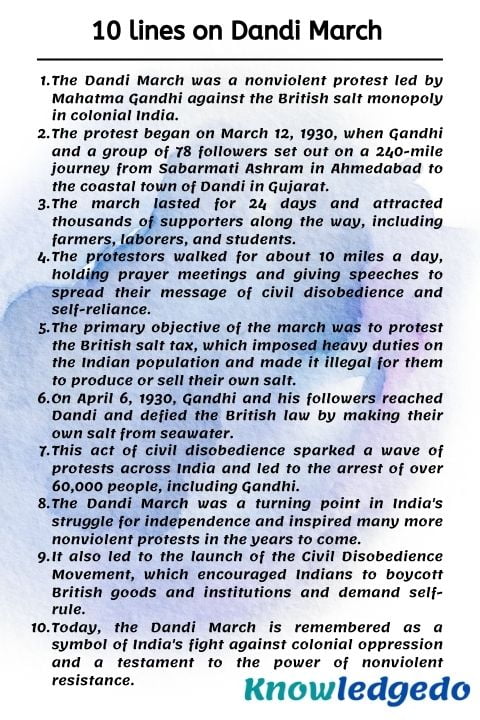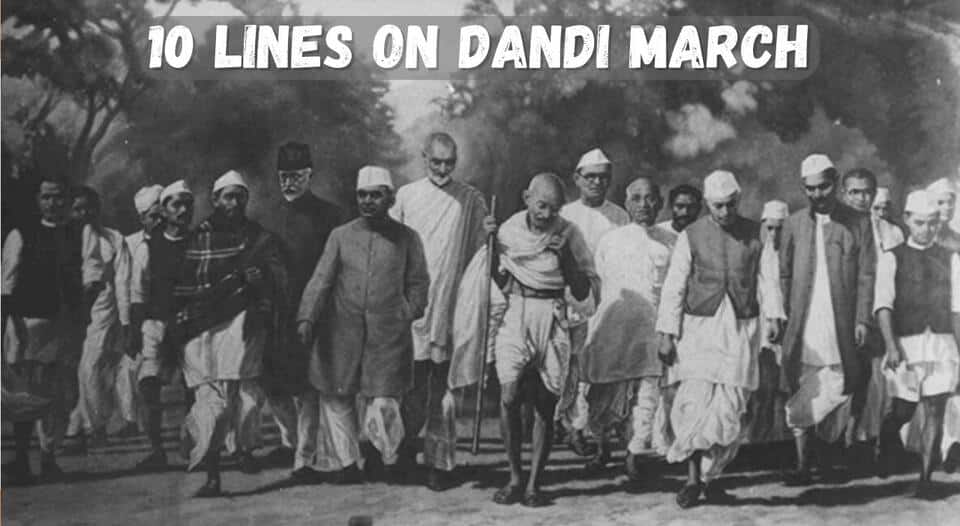Today, we are sharing 10 lines on Dandi March in English. This article can help students who are looking for information about 10 lines on Dandi March. This Lines is very simple and easy to remember. The level of these Lines is moderate so any student can write on this topic.
This article is generally useful for class 1,class 2,class 3,class 4,class 5,class 6,class 7,class 8,class 9,class 10,class 11,class 12
10 lines on Dandi March
1) The Dandi March was a nonviolent protest led by Mahatma Gandhi against the British salt monopoly in colonial India.
2) The protest began on March 12, 1930, when Gandhi and a group of 78 followers set out on a 240-mile journey from Sabarmati Ashram in Ahmedabad to the coastal town of Dandi in Gujarat.
3) The march lasted for 24 days and attracted thousands of supporters along the way, including farmers, labourers, and students.
4) The protestors walked for about 10 miles a day, holding prayer meetings and giving speeches to spread their message of civil disobedience and self-reliance.
5) The primary objective of the march was to protest the British salt tax, which imposed heavy duties on the Indian population and made it illegal for them to produce or sell their own salt.
6) On April 6, 1930, Gandhi and his followers reached Dandi and defied British law by making their own salt from seawater.
7) This act of civil disobedience sparked a wave of protests across India and led to the arrest of over 60,000 people, including Gandhi.
8) The Dandi March was a turning point in India’s struggle for independence and inspired many more nonviolent protests in the years to come.
9) It also led to the launch of the Civil Disobedience Movement, which encouraged Indians to boycott British goods and institutions and demand self-rule.
10) Today, the Dandi March is remembered as a symbol of India’s fight against colonial oppression and a testament to the power of nonviolent resistance.

5 lines on Dandi March
1) The Dandi March was a nonviolent protest against the British salt tax led by Mahatma Gandhi in 1930.
2) Gandhi and a group of followers walked 240 miles from Sabarmati Ashram to Dandi in Gujarat, where they made their own salt from seawater in defiance of British law.
3) The march lasted for 24 days and attracted thousands of supporters, sparking a wave of protests across India.
4) The Dandi March was a turning point in India’s struggle for independence and led to the launch of the Civil Disobedience Movement.
5) Today, the Dandi March is remembered as a symbol of India’s fight against colonial oppression and a testament to the power of nonviolent resistance.
FAQ
Answer: Gandhi chose salt as the focus of the Dandi March because the British salt tax was a symbol of their unjust colonial rule over India. The tax imposed heavy duties on the Indian population and made it illegal for them to produce or sell their own salt, which was a basic necessity of life.
Answer: The Dandi March was a turning point in India’s struggle for independence as it galvanized the Indian people to protest against colonial rule and demand self-rule. It also led to the launch of the Civil Disobedience Movement, which encouraged Indians to boycott British goods and institutions and demand independence.
Answer: The British authorities responded to the Dandi March by arresting over 60,000 people, including Gandhi, and using force to suppress protests. However, the nonviolent nature of the protests and the international attention they received put pressure on the British government to negotiate with Indian leaders and eventually grant India its independence in 1947.
Answer: The Dandi March is remembered as a symbol of nonviolent resistance because it demonstrated the power of peaceful protest in the face of oppression. Gandhi and his followers used civil disobedience and self-reliance to challenge the unjust British salt tax, inspiring many more nonviolent protests in India and around the world. The Dandi March is also seen as a reminder of the importance of fighting for justice and freedom through peaceful means.
